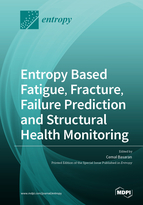Entropy Based Fatigue, Fracture, Failure Prediction and Structural Health Monitoring
A special issue of Entropy (ISSN 1099-4300). This special issue belongs to the section "Multidisciplinary Applications".
Deadline for manuscript submissions: closed (30 June 2020) | Viewed by 42451
Special Issue Editor
Interests: unified mechanics theory; mechanics of electronic materials; damage mechanics; fatigue; cyclic loading, fracture mechanics; degradation; thermodynamics; viscoplasticity; graphene; nanomechanics
Special Issue Information
Dear Colleagues,
In the last two decades, there has been significant progress in using entropy generation for damage and fracture mechanics and in-situ structural health monitoring of systems, ranging from infrastructures to mechanical and biological systems. Compared to phenomenological damage and fracture mechanics models based on empirical curve fitting a polynomial to a degradation and fracture data, using entropy provides a physics and mathematics-based alternative. Using either thermodynamic entropy or information theory entropy has been shown to be extremely successful in predicting the degradation, fracture, fatigue, and in-situ prognosis of all systems. It was proven by Jaynes [1957] that thermodynamic entropy is identical to the information theory entropy of the probability distribution, except for the presence of Boltzmann’s constant. The following are some examples of some of the most beneficial uses of entropy in the last two decades: thermodynamics entropy has been used as a bridge to unify the laws of Newtonian mechanics and thermodynamics to establish the unified mechanics theory. Information-theory entropy has been used successfully for fault diagnostics and prognostics of systems for in-situ structural health monitoring using various real-time signal feed-back cycles and computations. There is even a new pyroelectric sensor entropy detector to monitor energy conversion process in real time. There is a strong worldwide consensus among leading researchers that using entropy is scientifically the most accurate and reliable method for predicting degradation, fatigue, fracture, failure mechanics, and in-situ structural health monitoring of all systems. This Special Issue of the Entropy is devoted to covering the most recent advances in using entropy damage mechanics, and the structural health monitoring [fault diagnostics] of all systems.
Prof. Dr. Cemal Basaran
Guest Editor
Manuscript Submission Information
Manuscripts should be submitted online at www.mdpi.com by registering and logging in to this website. Once you are registered, click here to go to the submission form. Manuscripts can be submitted until the deadline. All submissions that pass pre-check are peer-reviewed. Accepted papers will be published continuously in the journal (as soon as accepted) and will be listed together on the special issue website. Research articles, review articles as well as short communications are invited. For planned papers, a title and short abstract (about 100 words) can be sent to the Editorial Office for announcement on this website.
Submitted manuscripts should not have been published previously, nor be under consideration for publication elsewhere (except conference proceedings papers). All manuscripts are thoroughly refereed through a single-blind peer-review process. A guide for authors and other relevant information for submission of manuscripts is available on the Instructions for Authors page. Entropy is an international peer-reviewed open access monthly journal published by MDPI.
Please visit the Instructions for Authors page before submitting a manuscript. The Article Processing Charge (APC) for publication in this open access journal is 2600 CHF (Swiss Francs). Submitted papers should be well formatted and use good English. Authors may use MDPI's English editing service prior to publication or during author revisions.







